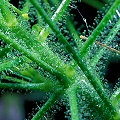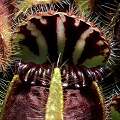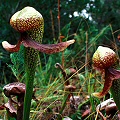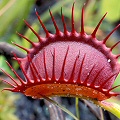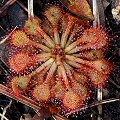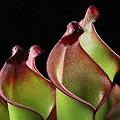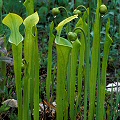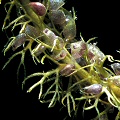| Utricularia 'Allure' |
Captive Exotics Newslett.1(4):7 (2011)
Details |
CP Photofinder |
Cultivar: Utricularia 'Allure' G.Bourke
Publication: Captive Exotics Newslett.1(4):7 (2011)
Comment: ? later synonym of Utricularia cornigera Studnicka
Synonym: =Utricularia nelumbifolia Gardn. * Utricularia reniformis St.Hil.
Originator: G.Bourke, Corrimal, NSW, AU, 2005
Nominant: G.Bourke, 2008
Registrant: G.Bourke, 9. 6. 2011
Horicultural comment: Registered 29. 6. 2011 {JS}
Standard: Captive Exotics Newslett.1(4):7, figs.1 & 2; 8, figs. 3 & 4 (2011)
Etymology: ?after attractivity of plant
Description: Captive Exotics Newslett.1(4):7 (2011)
"In 2005 I crossed Utricularia nelumbifolia Gardn. with the typical form of Utricularia reniformis St.Hil. producing seed on both parents. Of the offspring those with Utricularia nelumbifolia Gardn. as the female parent produced the most vigorous growth so one was selected for cultivation. Although the leaf was closest to Utricularia reniformis St.Hil., the plant regularly sent up vertical stolons never seen in that species. This trait is common in Utricularia nelumbifolia Gardn. which
enables it to inhabit bromeliads.(...)
In 2008 I flowered the hybrid Utricularia for the first time which I have chosen to distribute under the cultivar name Utricularia ' Allure ' G.Bourke. The plant produces reinform leaves to 10 cm on redmaroon petioles (Figure 1 & 4). Stolons are also brightly coloured particularly when exposed to strong light. The aerial stolons are much thicker than those produced by Utricularia nelumbifolia Gardn. and do not rise as far as the female parent but are successful in spreading through the leaf axils of many species of tank bromeliads particularly those with flatter and more open rosettes. This allows for successful control of mosquito larvae in bromeliads.
The flowers produced by Utricularia ' Allure ' G.Bourke are born on a scape to 50 cm high with 10-15 flowers being produced with 1-3 open at a time. Each flower is 3-5cm across and pale mauve in colour. 2 bright orange stripes on a white background appear in the palate, these are bordered with purple (Figure 2 & 3)."
|
| Utricularia 'Asenath Waite' |
Carniv.Pl.Newslett.30:76 (2001)
Details |
CP Photofinder |
Cultivar: Utricularia 'Asenath Waite' B.Rice
Publication: Carniv.Pl.Newslett.30:76 (2001) https://legacy.carnivorousplants.org/cpn/articles/CPNv30n3p75_77.pdf
Web Publication: https://legacy.carnivorousplants.org/cpn/Species/v30n3p75_77.html#UAW
Synonym: =Utricularia calycifida Benj.
Originator: B.Rice, 2000
Nominant: B.Rice, 30. 4. 2001
Registrant: B.Rice, Davis, USA, 30. 4. 2001
Horicultural comment: Registered 21. 10. 2001 {JS}
Standard: Carniv.Pl.Newslett.30:77 (2001)
Propagation: vegetative only
Etymology: after a witch noted in the story, "The Thing on the Doorstep" by H.P. Lovecraft. Asenath Waite shared many physical characteristics of her ancestor Mrs. Marsh of Innsmouth. Asenath also had an interesting propensity for shallow plantings in soft soils.
Description: Carniv.Pl.Newslett.30:76 (2001)
"Utricularia ' Asenath Waite ' B.Rice resulted from a cross I made in 2000 between Utricularia ' Lavinia Whateley ' B.Rice (seed parent) and Utricularia ' Mrs. Marsh ' B.Rice. Interestingly, Utricularia ' Asenath Waite ' B.Rice has prominent purple leaf venation absent in both its parents. The flowers of this new cultivar are distinctive. The corolla lips are large and have a lovely blue-lilac blush. The lower lip has a large palate bulge with a yellow splotch at the crest. The rest of the palate bulge is covered with spots similar to those on Utricularia 'Mrs. Marsh', but much bolder. Utricularia ' Asenath Waite ' B.Rice should only be propagated by vegetative means. There is no guarantee that seed progeny would maintain the characters of this cultivar. Furthermore, many Utricularia calycifida Benj. plants grown from seed are slow growing. In contrast, the highly vigorous nature of Utricularia ' Asenath Waite ' B.Rice in cultivation was the final criterion I demanded when breeding superior plants for cultivar status."
|
| Utricularia 'Betty's Bay' |
Carniv.Pl.Soc.J.(UK) 27:33 (2005)
Details |
CP Photofinder |
Cultivar: Utricularia 'Betty's Bay' S.Morley
Publication: Carniv.Pl.Soc.J.(UK) 27:33 (2005)
Web Publication: http://uk.geocities.com/garden_of_eden@btinternet.com/misc/bisquamata_Bettys_Bay_web.doc
Synonym: =Utricularia bisquamata Schrank
Originator: S.Morley, 1984, from Betty's Bay near Hermanus, E False Bay, Cape, ZA
Nominant: S.Morley, Fangfoss, York, England
Registrant: S.Morley, 23. 9. 2005
Horicultural comment: Registered 14. 11. 2005 {JS}
Standard: Carniv.Pl.Soc.J.(UK) 27:34 (2005)
Etymology: after the provenance of the cultivar
Description: Carniv.Pl.Soc.J.(UK) 27:35 (2005)
"The flowers of Utricularia 'Betty's Bay ' S.Morley are huge in comparison with typical specimens of Utricularia bisquamata Schrank, with the total height of the flower being up to 10 mm long, and the lower lip of the flower measuring up to 11 mm across at its widest point. The upper flower lip is pale yellow, with dark lilac longitudinal streaks, and is deeply notched at the apex giving the impression of 2 stubby "ears" at the top of the flower. The lower lip is predominantly lilac, but with an intense yellow patch at the base (top) of the lip; the lip is quite bulbous and ridged at this point, and there is an area of darker lilac between this and the rest of the lip. The spur is slightly curved, and size-wise about half of the total length of the flower long. When viewed from the front, the spur is not visible as it does not project below the lower lip. It is pale lilac in colour, fading towards the base (top). Each flower stalk can produce from 1 to several flowers in succession up the stalk; the specimen before me has 3 flowers/buds and measures 14 cm high, but is not yet fully grown. Unlike the "normal" form in cultivation, which readily self-pollinates and seeds profusely all over adjacent pots, Utricularia ' Betty's Bay ' S.Morley does not appear to set seed in cultivation unless hand pollinated."
|
| Utricularia 'Big Sister' |
Carniv.Pl.Newslett.33:52 (2004)
Details |
CP Photofinder |
Cultivar: Utricularia 'Big Sister' B.Rice & M.Studnicka
Publication: Carniv.Pl.Newslett.33:52 (2004) https://legacy.carnivorousplants.org/cpn/articles/CPNv33n2p52_55.pdf
Web Publication: https://legacy.carnivorousplants.org/cpn/Species/v33n2p52_55.html#sister
Comment: synonym of Utricularia cornigera Studnicka
Synonym: =?Utricularia reniformis St.Hil. * Utricularia nelumbifolia Gardn.
Nominant: B.Rice, Davis, CA, US & M.Studnicka, Liberec, CZ, 2003
Registrant: B.Rice & M.Studnicka, 15. 3. 2003
Horicultural comment: Registered 8. 9. 2004 {JS}
Standard: Carniv.Pl.Newslett.33:64 (2004)
Etymology: after the size of the plant
Description: Carniv.Pl.Newslett.33:52 (2004)
"The primary distinction between the two cultivars of Utricularia reniformis St.Hil. is size. At maturity, Utricularia ' Big Sister ' B.Rice & M.Studnicka consistently produces large leaves i.e. at least 8 cm in diameter. One of us (MS) has even observed a greenhouse specimen with leaves 22.2 cm in diameter, on a petiole 46 cm tall! Mature Utricularia ' Big Sister ' B.Rice & M.Studnicka specimens do not produce abundant small leaves (in contrast with Utricularia ' Enfant Terrible ' B.Rice & M.Studnicka, described below). A second feature distinguishing the two cultivars is the incision into the leaf where the petiole attaches to the leaf blade. In Utricularia ' Big Sister ' B.Rice & M.Studnicka, this cut is narrow (i.e. acute). See, for examples, the leaf lamina outlines in Taylor (1989), Figure 131 (figure elements 2,3,4). Floral characters are not considered important in distinguishing these two cultivars. Of the two Utricularia reniformis cultivars, Utricularia ' Big Sister ' B.Rice & M.Studnicka seems to be slightly more challenging to grow well. The giant leaves are not developed to perfection if the conditions are inadequate. This plant may perhaps be treated best as an epiphyte, and should be grown in a comparatively light, airy mix. Humidity should be high."
|
| Utricularia 'Brazilian Beauty' |
Carniv.Pl.Newslett.45:33 (2016)
Details |
CP Photofinder |
Cultivar: Utricularia 'Brazilian Beauty' G.Bourke
Publication: Carniv.Pl.Newslett.45:33 (2016)
Synonym: =Utricularia reniformis St.Hil. * Utricularia nephrophylla Benj.
Originator: G.Bourke, Corrimal, NSW, AU, 2010
Nominant: G.Bourke, 2015
Registrant: G.Bourke, 13. 12. 2015
Horicultural comment: Registered 14. 5. 2016 {JS}
Standard: Carniv.Pl.Newslett.45:1 (front cover), 33 (2004)
Etymology: after provenance of parent species and attractiveness of cultivar
Description: Carniv.Pl.Newslett.45:33 (2016)
"In 2010 I crossed several flowers of Utricularia reniformis St.Hil. and Utricularia nephrophylla Benj.. The resulting seed was germinated with a single vigorous clone selected to grow. Although both species and the cultivar are somewhat variable, the plant selected showed morphology intermediate between both parents in leaf size and shape (Fig. 1) as well as flower size and shape (Front Cover)."
|
| Utricularia 'Cthulhu' |
Carniv.Pl.Newslett.29:20 (2000)
Details |
CP Photofinder |
Cultivar: Utricularia 'Cthulhu' B.Rice
Publication: Carniv.Pl.Newslett.29:20 (2000) https://legacy.carnivorousplants.org/cpn/articles/CPNv29n1p14_21.pdf
Web Publication: https://legacy.carnivorousplants.org/cpn/Species/v29n1p14_21.html#cthulhu
Synonym: =Utricularia calycifida Benj.
Originator: ?, before 1990
Nominant: B.Rice, 17. 11. 1999
Registrant: B.Rice, Davis, USA, 22. 10. 1999
Horicultural comment: Registered 30. 3. 2000 {JS}
Standard: Carniv.Pl.Newslett.29:19 (2000)
Propagation: vegetative only
Etymology: in commemoration of the fictional creature described by H.P. Lovecraft, a denizen of a semi-aquatic land, and endowed with countless stolon-
like tentacles
Description: Carniv.Pl.Newslett.29:20 (2000)
"As I mentioned in a previous note (Carniv.Pl.Newslett.22:56, 1993), an interesting, mauve colored form of Utricularia calycifida Benj. is particularly noteworthy. This plant bears rounded, purple-veined leaves as does Utricularia ' Yog-Sothoth ' B.Rice. The flower is also large as in that cultivar, but differs in the details. First, the palate bulge is more rounded, pronounced and distinct from the rest of the lower corolla lip. Second - and most obviously - the yellow palate splotch is larger and surrounded by numerous anastomosing pale veins. The mauve-pink that contrasts with the pale veins is more saturated than the pink that colors the rest of the flower. The cultivar epithet "mauve flower" has not been established, so for this plant I propose instead the name Utricularia ' Cthulhu ' B.Rice."
|
| Utricularia 'Enfant Terrible' |
Carniv.Pl.Newslett.33:53 (2004)
Details |
CP Photofinder |
Cultivar: Utricularia 'Enfant Terrible' B.Rice & M.Studnicka
Publication: Carniv.Pl.Newslett.33:53 (2004) https://legacy.carnivorousplants.org/cpn/articles/CPNv33n2p52_55.pdf
Web Publication: https://legacy.carnivorousplants.org/cpn/Species/v33n2p52_55.html#terrible
Synonym: =Utricularia reniformis St.Hil.
Nominant: B.Rice, Davis, CA, US & M.Studnicka, Liberec, CZ, 2003
Registrant: B.Rice & M.Studnicka, 15. 3. 2003
Horicultural comment: Registered 8. 9. 2004 {JS}
Standard: Carniv.Pl.Newslett.33:54 (2004)
Etymology: after the difficulty/impossibility to obtain large plants of this cultivar
Description: Carniv.Pl.Newslett.33:53 (2004)
"Utricularia ' Enfant Terrible ' B.Rice & M.Studnicka is the smaller form of this species in cultivation. Its leaves never exceed approximately 4 cm in size, on petioles approximately 12 cm tall. An interesting feature of this cultivar is the production of a carpet of minute ground-leaves under the large aerial-leaves. The diameters of these leaves range from as small as only a few mm to as large as a few cm. Depending upon the cultivation conditions, Utricularia ' Enfant Terrible ' B.Rice & M.Studnicka may only have large aerial-leaves, minute ground-leaves, or both. In a relatively dry California greenhouse, one of us (BR) has observed this plant to grow only aerial leaves during the cool, amenable winter, and ground-leaves during the hotter, fierce summer. Another feature distinguishing Utricularia ' Enfant Terrible ' B.Rice & M.Studnickafrom Utricularia ' Big Sister ' B.Rice & M.Studnicka is in the nature of the leaf incision, where the petiole attaches to the leaf blade. In Utricularia ' Enfant Terrible ' B.Rice & M.Studnicka, the incision is typically obtuse (instead of acute, as in Utricularia ' Big Sister ' B.Rice & M.Studnicka). For examples, refer to the leaf lamina drawings in Taylor (1989), in particular Figure 131 (figure elements 5,6,7). Utricularia ' Enfant Terrible ' B.Rice & M.Studnicka is often confused with Utricularia nephrophylla Benj., which has 0.1-1 cm leaf blades. While the ground-leaves of Utricularia ' Enfant Terrible ' B.Rice & M.Studnicka can mimic the appearance of Utricularia nephrophylla Benj., the larger aerial leaves of Utricularia ' Enfant Terrible ' B.Rice & M.Studnicka are diagnostic. The flowers of these two species are also quite different. Horticulturists who possess Utricularia ' Enfant Terrible ' B.Rice & M.Studnicka are sometimes frustrated by this plant when, despite heroic cultivation measures, it does not produce gigantic leaves. This is not Utricularia ' Big sister ' B.Rice & M.Studnicka! On the other hand, Utricularia ' Enfant Terrible ' B.Rice & M.Studnicka survives easily in conditions where Utricularia ' Big Sister ' B.Rice & M.Studnicka might wither and perish. Utricularia ' Enfant Terrible ' B.Rice & M.Studnicka is grown easily in a variety of mixes, but prefers a relatively light soil."
|
| Utricularia 'Irene' |
Carniflora Australis 7(3):7 (2010)
Details |
CP Photofinder |
Cultivar: Utricularia 'Irene' G.Bourke
Publication: Carniflora Australis 7(3):7 (2010)
Synonym: =Utricularia uniflora R.Br.
Originator: G.Bourke, Corrimal, NSW, AU, from AU
Nominant: G.Bourke, 2010
Registrant: G.Bourke, 12. 6. 2010
Horicultural comment: Registered 29. 6. 2011 {JS}
Standard: Carniflora Australis 7(3):7, fig.4 (2010)
Propagation: by stolon division
Etymology: after introducer's grandmother
Description: Carniflora Australis 7(3):7 (2010)
"Utricularia ' Irene ' G.Bourke (Figure 4) is a selected clone of Utricularia uniflora R.Br. that produces white flowers with small violet blotches near the pallet of the lower lip. (...) Temperate conditions are preferred with damp to wet soil. This cultivar also flowers later in the season than other clones preferring mid to late summer."
|
| Utricularia 'Jitka' |
Carniv.Pl.Newslett.34:27 (2005)
Details |
CP Photofinder |
Cultivar: Utricularia 'Jitka' M.Studnicka
Publication: Carniv.Pl.Newslett.34:27 (2005) https://legacy.carnivorousplants.org/cpn/articles/CPNv34n1p27_28.pdf
Web Publication: https://legacy.carnivorousplants.org/cpn/Species/v34n1p27_28.html#jitka
Comment: priority for parentage
Synonym: =Utricularia quelchii N.E.Br. * Utricularia praetermissa P.Taylor
Originator: M.Studnicka, Bot. Gardens Liberec, CZ, 2000
Nominant: M.Studnicka
Registrant: M.Studnicka, 10. 7. 2004
Translation: Utricularia ' Judith ' M.Studnicka (English)
Horicultural comment: Registered 10. 10. 2005 {JS}
Standard: Carniv.Pl.Newslett.34:32 (back cover) (2005)
Propagation: division
Etymology: after Jitka Strasserova, a friend of the originator
Description: Carniv.Pl.Newslett.34:27 (2005)
"The plant has the general floral and leaf structure of the paternal parent. The flower color, however, is quite different; while the flowers of Utricularia praetermissa P.Taylor are typically white or pale pink with a yellow palate splotch, the flowers of this cultivar are a splendidly rich mauve, with a prominent vitelline palate splotch. The leaves are petiolate, with obovate laminae. Each petiole is up to 7 cm long, the lamina measures up to 7 x 3 cm. Including the typical spray of 3-4 flowers, the entire inflorescence is up to 30 cm long. The flower stalk is stiff, and about 2 mm thick. A whorl of three narrow bracts is at the base of each flower pedicel; an additional whorl of bracts occurs on the peduncle, at about 2/3 of the distance from the ground to the lowermost flower. The whorls are rather strange, because they are serried, with two bracts crossed one over the other. The flowers open progressively from below, and thanks to their durability, the earliest flowers to open are still in good condition when the last flower opens, resulting in a very impressive and beautiful show! It is vigorous, and produces flowers frequently, time and time again. The flowers are large - the lower lip of corolla measures 34 mm in length and 52 mm in width. The smaller, upper lip is shorter than the upper calyx lobe, and is mostly hidden by it. The spur is falcate - it reaches the margin of the lower lip, but does not curve backwards at the apex as does the spur of Utricularia praetermissa P.Taylor."
|
| Utricularia 'Johore' |
Das Grosse Buch d.Wasserpfl.:212 (1980)
Details |
CP Photofinder |
Cultivar: Utricularia 'Johore' Muehlberg
Publication: Das Grosse Buch d.Wasserpfl.:212 (1980)
Synonym: =Utricularia aurea Lour.
Originator: Muehlberg, from Johore, Malaysia
Nominant: Muehlberg
Horicultural comment: name not established (no description, violating Art.24.1., ICNCP)
Etymology: after the locality from which the plants were collected
|
| Utricularia 'Lavinia Whateley' |
Carniv.Pl.Newslett.29:20 (2000)
Details |
CP Photofinder |
Cultivar: Utricularia 'Lavinia Whateley' B.Rice
Publication: Carniv.Pl.Newslett.29:20 (2000) https://legacy.carnivorousplants.org/cpn/articles/CPNv29n1p14_21.pdf
Web Publication: https://legacy.carnivorousplants.org/cpn/Species/v29n1p14_21.html#lavinia
Synonym: =Utricularia calycifida Benj.
Originator: ?, before 1990
Nominant: B.Rice, 17. 11. 1999
Registrant: B.Rice, Davis, USA, 22. 10. 1999
Horicultural comment: Registered 30. 3. 2000 {JS}
Standard: Carniv.Pl.Newslett.29:18 (2000)
Propagation: vegetative only
Etymology: honors the peculiarly pale, white-haired woman who appeared in H.P. Lovecrafts short novel, The Dunwich Horror
Description: Carniv.Pl.Newslett.29:20 (2000)
"As I mentioned in a previous note (Carniv.Pl.Newslett.22:56, 1993), a white-flowered variant of Utricularia calycifida Benj. exists and has been grown with the name Utricularia calycifida Benj. "white flower". This epithet has not been registered, and since it is overly ambiguous, I propose instead the name Utricularia ' Lavinia Whateley ' B.Rice. This cultivar's flower is similar in form to that of Utricularia ' Yog-Sothoth ' B.Rice, except instead of predominantly pink, the flower is white. The yellow palate splotch is present. The leaf veins are not heavily tinted purple."
|
| Utricularia 'Merrie Heart' |
Carniv.Pl.Newslett.40:97 (2011)
Details |
CP Photofinder |
Cultivar: Utricularia 'Merrie Heart' D'Amato
Publication: Carniv.Pl.Newslett.40:97 (2011)
Synonym: =Utricularia livida E.Mey.
Originator: P.D'Amato, Sebastopol, Ca., US, from MX, before 2011
Nominant: P.D'Amato
Registrant: P.D'Amato, 13. 6. 2011
Horicultural comment: Registered 20. 10. 2011 {JS}
Standard: Carniv.Pl.Newslett.40:97 (2011)
Propagation: vegetative
Etymology: after the affectionate spelling F.E.Lloyd used for his beloved wife, Mary Hart
Description: Carniv.Pl.Newslett.40:97 (2011)
"The Mexican variety is even more attractive in flower than the African variety and is equally easy to grow. It flowers prolifically, most often from spring through autumn, but it can bloom in winter as well if kept warm and in high light levels. It is tolerant of light frost and brief freezes.
The flower stalks average 7.5 to 15 cm in height but can be taller, with upper portions of the stalk each lasting several weeks in bloom. The flower's apron-like lower lip is slightly irregular along its edge, suffused with purple-violet coloration, and measures nearly 1 cm across (see Fig. 2). The tiny upper lip is two-pronged. The forward facing curved spur is hidden below the larger lower lip and is also violet in color. There is no yellow throat in the spur, as in its African sibling. It has never produced seed to my knowledge, but is easily propagated through divisions. The sizeable surface stolon are irregularly tear-drop shaped and measure roughly 1 cm in length."
|
| Utricularia 'Mrs. Marsh' |
Carniv.Pl.Newslett.29:20 (2000)
Details |
CP Photofinder |
Cultivar: Utricularia 'Mrs. Marsh' B.Rice
Publication: Carniv.Pl.Newslett.29:20 (2000) https://legacy.carnivorousplants.org/cpn/articles/CPNv29n1p14_21.pdf
Web Publication: https://legacy.carnivorousplants.org/cpn/Species/v29n1p14_21.html#marsh
Synonym: =Utricularia calycifida Benj.
Originator: ?, received from P.McMillan, Arizona, before 1990
Nominant: B.Rice, 17. 11. 1999
Registrant: B.Rice, Davis, USA, 22. 10. 1999
Horicultural comment: Registered 30. 3. 2000 {JS}
Standard: Carniv.Pl.Newslett.21:12 (1992)
Propagation: vegetative only
Etymology: in commemoration of the second wife of Captain Obed Marsh, from H.P. Lovecrafts tale, The Shadow over Innsmouth, a mysterious figure known for her froglike appearance and strange affinity to water
Description: Carniv.Pl.Newslett.29:20 (2000)
"In an article on Utricularia calycifida Benj. (Carniv.Pl.Newslett 21: 9-13, 1992) I discussed a clone that I referred to as "spotted flower". This unestablished epithet is being abandoned, and the cultivar name Utricularia ' Mrs. Marsh ' B.Rice is being established in its place. I described the flower of Utricularia ' Mrs. Marsh ' B.Rice in detail in that article, and for convenience I am using the Figure 2 that appeared on page 12 as a photographic standard. In summary, Utricularia ' Mrs. Marsh ' B.Rice can be recognized by its small white to pale-lilac flower. The corolla lips are decorated with small purplish-brown spots which are sometimes stretched into streaks. The orange-yellow palate splotch is edged in brown. The overall effect is remarkably similar to the patterning on some frogs or tiger cowrie sea shells (Cypraea tigris). The leaves are strap shaped, and are purplish only when growing rapidly."
|
| Utricularia 'Nuedlinger Flair' |
Carniv.Pl.Newslett.37:110 (2008)
Details |
CP Photofinder |
Cultivar: Utricularia 'Nuedlinger Flair' T.Carow
Publication: Carniv.Pl.Newslett.37:110 (2008)
Comment: priority for parentage
Synonym: =Utricularia alpina Jacq. * Utricularia humboldtii Schomb.
Originator: T.Carow, Nuedlingen, DE, 6. 1994
Nominant: T.Carow, 10. 5. 2006
Registrant: T.Carow, 25. 10. 2007
Horicultural comment: Registered 15. 12. 2008 {JS}
Standard: Carniv.Pl.Newslett.37:124 (2008)
Propagation: vegetative only
Etymology: after village fair at breeder's locality
Description: Carniv.Pl.Newslett.37:110 (2008)
"The petioles look similar to those of Utricularia alpina Jacq., but have a much longer stalk. The lamina is obovate to broadly lanceolate and up to 10 cm long and 4 cm wide. In shady conditions, the leaf stalk is up to 20 cm long, so the whole leaf could be up to 30 cm long. The traps looks similar to those of Utricularia alpina Jacq. and are about 1 mm in diameter.
The flowers are produced mainly in early summer. The inflorescence reaches up to 30 cm in length and usually bears two to four flowers. The flowers share more characteristics of Utricularia humboldtii Schomb. and are usually the same size as that species. They are about 5 cm long and beautifully colored. The corolla has the blue-violet coloration of Utricularia humboldtii Schomb., the lower lip has two very conspicuous, swollen yellow rims on the palate, which are prominent as in Utricularia humboldtii Schomb.. These rims are surrounded by a beautiful white spot, which however is much larger than in Utricularia humboldtii Schomb.. The yellow rims with the white spot in the middle of the blue-violet corolla give a nice contrast as it is not found in any of the large flowered Utricularia species or hybrids. The calyx lobes are equal, narrowly ovate, about 2 cm long and have the same coloration as the corolla.
I grow the plants in pure sphagnum moss, where they produce numerous offshoots and cover the whole surface very quickly. The plants like to grow in similar conditions as Utricularia alpina Jacq., not so wet as Utricularia humboldtii Schomb.. The temperatures in winter are about 12 degC, in summer around 15-25 degC. They get about 3-4 hours of direct sunlight per day."
|
| Utricularia 'Pittier Moon' |
Carniv.Pl.Newslett.36:118 (2007)
Details |
CP Photofinder |
Cultivar: Utricularia 'Pittier Moon' Wyman & Hoogenstrijd
Publication: Carniv.Pl.Newslett.36:118 (2007)
Synonym: =Utricularia alpina Jacq.
Originator: T.H.Wyman, Stone Mountain, GA, USA, from Henry Pittier National Park, before 2006
Nominant: T.H.Wyman & G. Hoogenstrijd, 12. 12. 2006
Registrant: T.H.Wyman & G.Hoogenstrijd, 17. 1. 2007
Horicultural comment: Registered 24. 12. 2007 {JS}
Standard: Carniv.Pl.Newslett.36:119 (2007)
Propagation: vegetative only
Etymology: after Henry Pittier National Park
Description: Carniv.Pl.Newslett.36:118 (2007)
"This plant is significantly more robust when compared to the more typical forms of Utricularia alpina Jacq. found in cultivation (...) and has occasionally been referred to by horticulturists as a "giant" or "large" form. The leaves are large - typically 20-45 cm long and 4-8 cm wide. This is 2-6 times the size of typical clones in cultivation, which for us are 8-20 cm long and 1.5-4 cm wide. They are also quite thick and almost succulent in texture. In outline they are diamond-shaped with a distinct petiole. Likewise, the blooms of this plant are 1.5-2.5 times larger than those of typical clones (see Figure 2) Flowers are typically born 2-4 on an inflorescence and, other than their large size, are typical for the species."
|
| Utricularia 'Yog-Sothoth' |
Carniv.Pl.Newslett.29:17 (2000)
Details |
CP Photofinder |
Cultivar: Utricularia 'Yog-Sothoth' B.Rice
Publication: Carniv.Pl.Newslett.29:17 (2000) https://legacy.carnivorousplants.org/cpn/articles/CPNv29n1p14_21.pdf
Web Publication: https://legacy.carnivorousplants.org/cpn/Species/v29n1p14_21.html#yog
Synonym: =Utricularia calycifida Benj.
Originator: ?, from VE, before 1990
Nominant: B.Rice, 17. 11. 1999
Registrant: B.Rice, Davis, USA, 22. 10. 1999
Horicultural comment: Registered 30. 3. 2000 {JS}
Standard: Carniv.Pl.Newslett.21:10 & 12 (1992)
Propagation: vegetative only
Etymology: notes the potent and enigmatic entity mentioned in various stories by H.P. Lovecraft, the original Yog-Sothoth and the cultivar share features such as peculiar venation, countless sucking mouths, and an insatiable appetite
Description: Carniv.Pl.Newslett.29:17 (2000)
"I used the tentative, descriptive phrase "purple veins" to describe one commonly cultivated form. This form has petiolate leaves with a oval lamina that are veined throughout with deep purple pigmentation (see Carniv.Pl.Newslett.21:10, Figure 1:1). The flowers are large, and the apron-like lower corolla lobe hangs down and nearly completely hides the spur. The corolla is pink, but with a yellow patch (edged in white) on the proximal palate bulge (see Carniv.Pl.Newslett.21:12, Figure 3). This plant is being established as the cultivar Utricularia ' Yog-Sothoth ' B.Rice."
|

